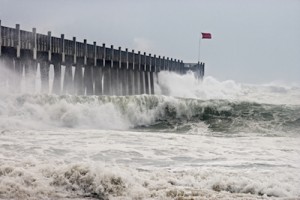Background
Most people accept that there are risks in life, from natural forces and disease and accidents, and most purchase insurance policies to provide protection against such risks. When people experience a catastrophe and lose valuable property, they turn to their insurance company to make them whole again, to the extent possible. They do not always get what they thought they had bargained for, and some insurance companies have the reputation of being in the business of denying claims, as their means of making money.
So it is a bit surprising to find oneself admiring an insurance company. The admiration grows out of the role insurance companies such as Lloyd’s, and others, have assumed in promoting an understanding of the risks from climate change. This is not altruistic of course. It is the business of insurance companies to understand the nature and extent of risks to which people are exposed, and placing a value on the monetary extent of such risks and then pricing their policies to reflect the risk and costs.
Over the past several decades insurance companies have been assessing the impacts already being felt and expected to arise as a result of climate change as these impacts can have significant effects on the risks that the companies will insure. Insurance companies are far ahead of many industries and many governments when it comes to accepting climate change and, more importantly, building that acceptance into the way they do business.
Catastrophe Modelling Report
One recent example of these efforts is the study by Lloyd’s, Catastrophe Modelling and Climate Change (2014). The report assesses the current status and use of modeling for catastrophes and how this work can inform insurance decisions for the short term, over a decade, and for the longer term. Of course, the short term and long term in climate change is quickly merging as demonstrated by a recent study by the US, National Climate Assessment, which summarizes the impacts of climate change on the United States, now and in the future. What the study finds is that the future is now. “Climate change, once considered an issue for a distant future, has moved firmly into the present,” the scientists declared in this major new report.
The Lloyd’s report provides a summary of familiar impacts from climate change, most recently detailed in the Intergovernmental Panel on Climate Change (IPCC) in its 5th Assessment Report, especially the impact on and from extreme weather events. For example, the frequency of heat waves has increased in Europe, Asia and Australia, and more areas show an increase in the number of heavy precipitation events. The report indicates that it is “virtually certain that since the 1970s there has been an increase in the frequency and intensity of the strongest tropical cyclones in the North Atlantic basin.” At 4.
Insurers need to assess the chances that an event will occur and the severity of that event, which in turn enables the insurer to put a price on the event and on a policy to cover such an event. Assessing risks for someone’s death typically relies on standard actuarial techniques, but such measures are not helpful for dealing with extreme weather events, especially for determining risks of low frequency but high severity risks. With climate change, low frequency but high severity risks are becoming even more problematical for assessing insurance risks. There is little historical loss data for these events, yet their severity can threaten an insurer’s solvency.
The need for better forecasting was made abundantly clear after the industry, in 1989, paid out $4bn for Hurricane Hugo losses and $6bn for the Loma Prieta earthquake, and then was hit with about $15bn from Hurricane Andrew. As a result an estimated 11 insurers became insolvent.
Adding further urgency for better forecasting of catastrophic losses was increasing population densities and property in hazard prone areas. Almost everywhere, people wanted to live by water and were willing and able to pay high prices for doing so.
By the 1980s, the insurance industry turned to catastrophe modeling to anticipate the likelihood and severity of potential future catastrophes and to adequately prepare for their financial impact.
The models are used for risk selection and underwriting, reserving and ratemaking, development of mitigation strategies, pricing and other decision-making and capital setting activities. Reinsurers, governments, and financial institutions have also turned to catastrophe modelling. After 9/11, models were also developed for man-made, or terrorist, catastrophes.
Catastrophe models rely on a variety of existing data, including data on windstorm clustering, inter-country demand surge relationships, occurrence and impact of storm surge, business interruption losses, damages from hurricanes beyond coastal areas. All the relevant, existing data is then applied to the insurer’s list of insured properties or clients to quantify the probability and size of potential loss.
After reviewing the current status of climate change assessments and the ways that insurers are trying to incorporate those assessments into catastrophe modeling, the Lloyd’s report then presents a series of case studies that examine how such modeling is used to address long term climate change trends.
Several studies examine European windstorms. Currently these storms track across the Northern latitude of Europe, particularly impacting Ireland, the UK, and Scandinavian countries. While only 1/3 of these windstorms result in insured losses, the danger is that any temporal clustering of such storms, such as happening in a 72 hour period, triggers reinsurance claims and higher losses. With climate changes, including to near-surface temperature and sea-ice, the strength and location of these events will result in: fewer smaller storms but increase in frequency of very large storms; a shift in latitude toward central Europe; and a 4-fold increase in frequency of years with several severe storms. The study estimates, for insurance risks, a 3-5% decrease in total number of potentially damaging storms but a 10-20% increase in number of larger storms, with severe storm losses impacting France and Germany.
Despite the increased precipitation in many areas, the report acknowledges the difficulty in assessing the magnitude or frequency of floods, in part because river management, including land uses and drainage works, is an important factor influencing trends in flooding. Nevertheless, one of the case studies estimates that by 2080 in the United Kingdom (UK) the winter rainfall will increase 3 times the number of days in winter where there is heavy rainfall (more than 25 mm/day), river flooding in peak flows will increase by 20-30%, and sea level will rise from 36 cm (14 in) to as much as 2 meters (6.5 ft). The UK Environmental Agency has estimated that £20 million above inflation per year is needed for flood defences just to stand still and avoid increasing risks from flooding.
NOAA
In another case study, it is reported that the North Atlantic hurricanes have resulted in significantly higher losses and pose the greatest threat of catastrophic damages along US eastern seaboard, gulf coast and throughout the Caribbean. As with flooding, there are large uncertainties about the precise effect of climate change on hurricanes but it is reported that the frequency of most intense storms are expected to increase in most basins and tropical cyclone rainfall is expected to increase significantly for most storms. Of critical importance to the modeling is the relationship between sea surface temperature and hurricane activity, as well as the impact from storm surge. Storm surge in particular had sweeping effects in Hurricanes Katrina (2005), Ike (2008) and Superstorm Sandy (2012). It is pointed out that the 20 cm (almost 8 in) sea-level rise at the Battery, in lower Manhattan since the 1950s increased sandy’s ground-up surge losses by 30% in New York alone.
Conclusion
Certain insurance companies have been at the forefront of promoting an understanding of the impact of climate change on business practices. Another interesting, and aggressive, tactic is where insurance companies have begun filing lawsuits against cities in the United States. The cities are demanding that the insurers reimburse them for losses that result from natural and other disasters. The insurers are now suing the cities on the grounds that the losses were reasonably foreseeable and the cities failed to take the necessary preventive actions to avoid these disasters. As the consensus about climate change strengthens, these lawsuits likely will increase and the insurers will question why the cities did not take mitigation or adaptation measures. Of course, the same argument could be used by insurers against any company or even individuals.
Sources
Lloyd’s, Catastrophe Modelling and Climate Change (May 2014). www.lloyds.com/news-and-insight/news-and-features/emerging-risk/emerging-risk-2014/keying-climate-change-into-catastrophe-models
U.S. Global Change Research Program, National Climate Assessment (May 2014). nca2014.globalchange.gov/ The study was undertaken by a team of more than 300 experts guided by a 60-member Federal Advisory Committee and it was extensively reviewed by the public and experts, including federal agencies and a panel of the National Academy of Sciences.
Justin Gillis, “U.S. Climate Has Already Changed, Study Finds, Citing Heat and Floods” New York Times (May 6, 2014). www.nytimes.com/2014/05/07/science/earth/climate-change-report.html?_r=0


No comments yet, add your own below